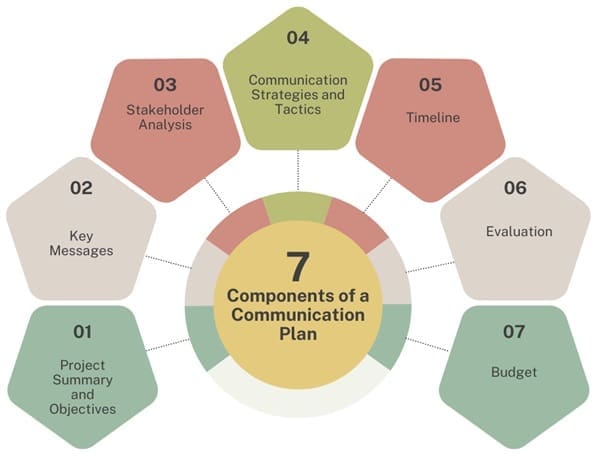A communication plan is a strategic framework designed to convey consistent, coordinated, and targeted messages to achieve specific goals. It outlines how, when, and to whom information will be disseminated within a project or organization to ensure that all stakeholders are informed and engaged. The plan helps to streamline communication efforts, making them more effective and efficient.
Table of contents
Why Use a Communication Plan?
- Focus and Clarity: A communication plan helps to focus your message, ensuring that it is clear and impactful.
- Consistency: It ensures that messaging is consistent across all channels and platforms.
- Efficiency: By planning communication efforts, resources such as time and money are used more effectively.
- Measurement: It provides a framework for monitoring and evaluating the success of communication efforts.
Steps to Develop an Effective Communication Plan

Specify Goals
First, clarify what you aim to achieve through your communication efforts. Outline the overarching goals of your communication plan, ensuring they align with and support your project’s objectives.
Identify Target Audiences and Objectives
Identify the groups or individuals you need to engage. Typical audiences might include:
- State education agency staff
- District and school administrators
- Teachers
- Counselors
- Curriculum coordinators
- Professional development providers
- Curriculum developers
- Parents/guardians
- Legislative staff
- Media outlets, reporters, bloggers
- Community members
- Researchers
Ask yourself
- Who are the primary and secondary audiences?
- Who needs to know about your message?
- Who is discussing this topic?
- Who has written about this topic?
Define communication objectives for each audience, such as raising awareness, changing attitudes, or motivating action.
Craft Key Messages
Develop clear, concise key messages tailored to each audience. These messages should be easily understood and memorable. Start with a summary of your main points and distill this into three to five brief statements. Ensure each key message aligns with your communication goals and resonates with your audience.
Determine Communication Strategies
Decide how you will share your key messages and achieve your objectives for each audience. Examples include:
- Social media posts
- E-blasts
- Website promotions
- Newsletters
- Press releases
- Blog posts or articles
- Fact sheets/one-pagers
- Policy briefs
- Executive summaries
- Reports
- Guides or booklets
- Case studies/testimonials
- Infographics/posters/data dashboards
- Videos/documentaries
- Presentations/briefings
- Webinars
- In-person events or conferences
Choose strategies that match your audience’s preferences and your available resources. Adapt and repurpose your content across different platforms to maintain consistency and reach.
Develop a Dissemination and Outreach Plan
Identify the channels you will use to distribute your messages and products. This could include mailing lists, social media accounts, newsletters, and websites. Develop an outreach list of individuals, organizations, and networks that can help share your content.
Consider creating a media kit with sample products like social media posts, e-blasts, and newsletter items. Engage with media outlets if your topic is newsworthy.
Create a Timeline
Establish a timeline to manage your communication efforts. Include planning, production, and dissemination activities. Assign responsibilities and set deadlines. Time your activities to coincide with key events or news stories to maximize impact. Plan a big initial push followed by staggered releases to maintain momentum.
Measure the Results
Define what success looks like and list measurable outcome goals. Use tools like Google Analytics to track stakeholder reach and engagement. Regularly evaluate your communication efforts by asking:
- Are we effectively reaching and engaging our target audiences?
- Are our audiences retaining and repeating our messages?
- Is our messaging producing the desired outcomes?
Adjust your strategies based on this evaluation to improve your communication plan continuously.
Components of a Communication Plan

- Project Summary and Objectives: Provide a background to the project and outline the communication objectives. This ensures everyone involved understands the context and purpose of the communication efforts.
- Key Messages: Identify the core messages you want to convey. These should be clear, concise, and consistent across all communications.
- Stakeholder Analysis: Identify your target audiences and analyze their needs and preferences. Tailor your messages and communication strategies to each group.
- Communication Strategies and Tactics: Detail the methods you will use to deliver your messages. This includes choosing the right channels and formats for each audience.
- Timeline: Develop a schedule for your communication activities. This helps you manage your efforts and ensures that messages are delivered at the right time.
- Evaluation: Plan how you will assess the effectiveness of your communication efforts. Use metrics and feedback to measure success and make improvements as needed.
- Budget: Outline the resources required for your communication plan, including costs for materials, media production, and any other expenses.
Example of a Communication Plan
Goal: Raise awareness about a new health initiative in the community.
Target Audiences:
- Community members
- Healthcare providers
- Local media
- Policy makers
Key Messages:
- The new health initiative aims to improve community well-being.
- Free health screenings will be available at local clinics.
- The initiative is supported by local healthcare providers and policymakers.
Strategies and Tactics:
- Social Media: Regular posts on Facebook and Twitter to keep the community informed.
- Press Releases: Announce the launch of the initiative and upcoming events to local media.
- Newsletters: Monthly updates to healthcare providers and community leaders.
- Events: Host a community health fair to kick off the initiative.
Timeline:
- Month 1: Announce the initiative with a press release and social media campaign.
- Month 2: Host the community health fair.
- Month 3: Begin monthly newsletters to stakeholders.
Evaluation:
- Track social media engagement and website visits.
- Survey attendees at the health fair to gather feedback.
- Monitor participation in health screenings.
Final Word
Developing a communication plan is essential for ensuring your message reaches the right audience effectively. By following these steps, you can create a strategic, coordinated, and consistent communication plan that helps you achieve your goals.


















